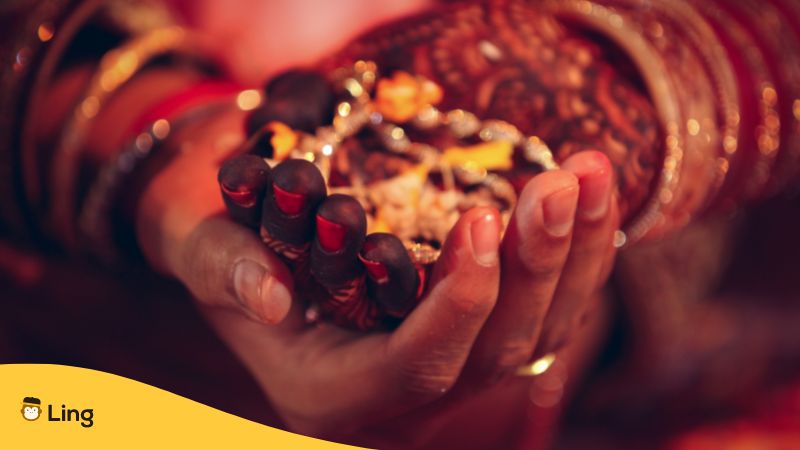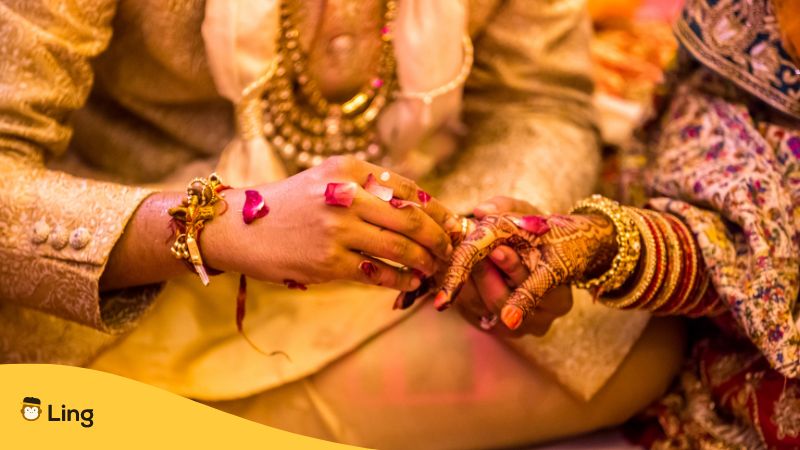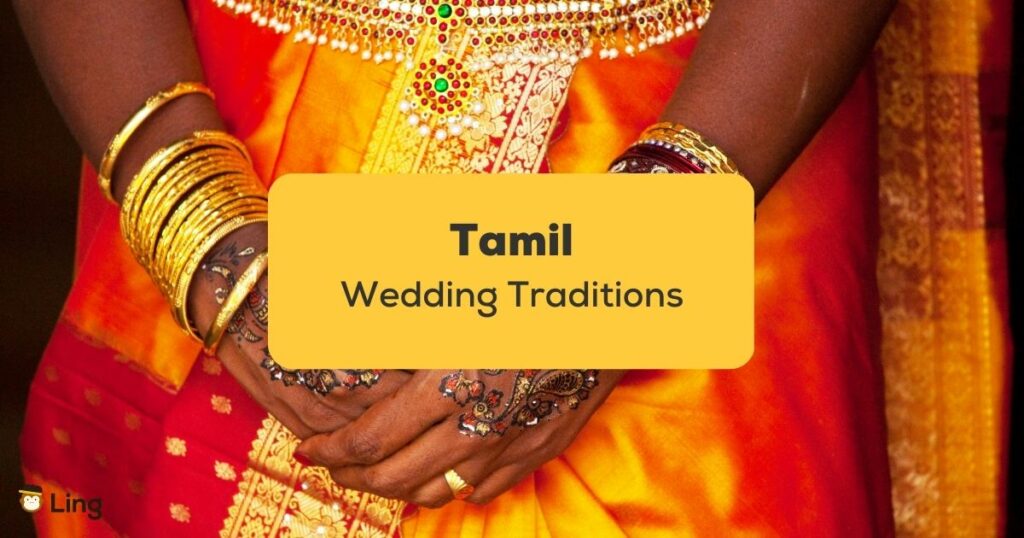Marriage or திருமணம் (pronounced as Tirumaṇam) is considered an important rite of passage in Tamil culture. It is seen as a sacred bond between two individuals and their families and viewed as a union that brings together two individuals and two families. The Tamil wedding traditions are grand, elaborate, and sacred, with many customs and rituals steeped in the culture. In this article, we’ll learn more about this and the terminologies for each tradition. Let’s start!
Tamil marriages are typically arranged marriages, and families play a significant role in selecting partners. Yes – your life partner is chosen by your parents and relatives, not you. The couple’s compatibility is usually assessed by considering factors such as family background, education, and financial stability. The wedding ceremony includes rituals like engagement, pre-wedding rites, wedding day rituals, and post-wedding rituals.
Marriage is seen as a lifelong commitment in Tamil culture, and divorce is not shared. Traditionally, the couple is expected to live together for the rest of their lives and to take care of each other through thick and thin. The couple is also likely to have children and raise them in a traditional Tamil home.

How Do Arranged Marriages Happen?
In a Tamil wedding, arranged marriages are the norm, and the families typically select the bride and groom. Like all good things, the process starts with introductions of both families. Families of the bride and groom get to know each other and share information about their respective families, including their backgrounds, education, and financial stability.
Once the families have agreed to proceed with the marriage, the bride and groom will meet each other, usually in the presence of their families. An essential part of their meetings is ஜாதகப் பொருத்தம் Horoscope Matching. The families will have the couple’s horoscopes evaluated by an ஜோதிடர் astrologer to determine if they are compatible. It is also a deal-breaker sometimes! If the horoscopes do not match, no marriage will occur.
The next step is the reference check. The families usually conduct a background check of the prospective bride and groom, including checking for the families’ reputation and social status before making a final decision. Then, the wedding date is fixed.

Tamil Wedding Traditions
Before any wedding ceremony, a பாண்ட கால் முஹூர்த்தம் Panda Kaal Muhurthamtakes place. This prayer is held in each home for a peaceful and uninterrupted wedding ceremony. The ceremony typically includes the following steps:
- நிச்சயதார்த்த விழா Engagement ceremony: The formal engagement ceremony is generally held at the groom’s family home and is a formal announcement of the upcoming wedding. The bride and groom exchange engagement rings, and the families exchange gifts. There may also be discussions about a wedding date on this occasion. The wedding venue can also be a topic to get the opinions of both families. It is respectful to know the wishes and expectations of the bride’s family and the groom’s.
- Pre-wedding rituals: These rituals include the மங்கள ஸ்நானம் Mangala Snaanam (auspicious bath) and மாலை மாடல் maalai matral (exchange of garlands).
- Wedding Day: The wedding day is typically divided into three parts: the பாலிகை தெல்லிச்சல் pallikai thellichal (exchange of rings), மாங்கல்ய தாரணம் maangalya dharanam (tying of the sacred thread), and சப்தபதி saptapadi (seven steps) ceremonies.
- பாலிகை தெல்லிச்சல் Pallikai Thellichal: The couple exchanges rings in the presence of the priest and the family members.
- மாங்கல்ய தாரணம் Maangalya Dharanam: The bride’s father ties a sacred thread around the bride’s neck, symbolizing her marriage and transition into a new life.
- சப்தபதி Saptapadi: The couple takes seven steps around a sacred fire, making seven promises to each other. This symbolizes the start of their journey together as a married couple.
- Post-wedding rituals: These rituals include the “reception” and விதாய் vidaai (farewell) ceremonies. The reception is typically held at the groom’s house, where the couple receives blessings from their family and friends. The விதாய் Vidaai ceremony is when the bride leaves her parent’s house to join her husband’s family.
These seven steps conclude the Tamil wedding traditions.
Types Of Tamil Weddings
There are different types of marriages among Tamils. It will be nice to get a glimpse of each type. Arranged marriages are the most common. Occasionally, you find lucky lovebirds with supportive non-traditional, or mixed family members.
Love marriage means the couple has chosen each other and has been in a relationship before getting married; both the bride and groom’s families accept this. Inter-caste marriages are where the bride and groom belong to different castes. In a south Indian wedding, the same caste is mostly preferred.
As the name suggests, inter-religion marriages are also becoming accepted marriages where the bride and groom’s families belong to different religions. The final is child marriage which is not widely accepted as one of the Tamil wedding types and is illegal in India but does exist to date.
As a note, do remember that the Tamil wedding traditions differ between each of these types of marriages.

Ling App To Learn Tamil
Enjoyed learning about Tamil wedding traditions? We can’t blame you! The locals just have a fairly unique way of starting married life, making it a fun experience for all. You can also learn more about Tamil culture by reading our blog post on traditional Tamil food or even watching a Tamil movie to get a feel of the local language and culture.
But if you’re interested in mastering the language and speaking it like a pro, there’s nothing more we can recommend than learning Tamil using Ling. Ling is a fantastic language-learning app made specifically to help beginners master the intricacies of Tamil and 60+ other languages. It also features new features that’ll help you learn the language faster than ever. Try it out today by downloading the app from Play Store or App Store and start learning Tamil the right way!















